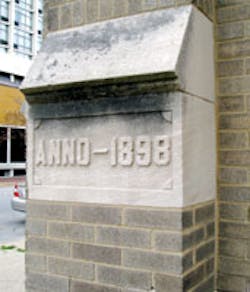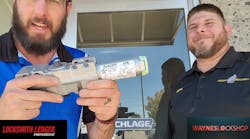For want of a better expression, locksmithing deals with the after market. Once the ‘experts’ have decided which hardware to use during new construction, building owners often find they have installation problems ranging from poor quality hardware to completely wrong hardware for the intended purpose.
Hardware problems may either appear weeks after being installed or the owners may suffer with the problems for many years before finally realizing that something must be done. Regardless of the time delay, locksmiths are depended upon to have the right answer for the problem and to have the experience and know-how to complete the reinstallation.
A sterling example of locksmithing in action is this hardware installation in an old church. The church was constructed in 1898 (photo 1). The original installation used a mortise front door lock with standard door knobs (photo 2). Sometime in the last 100 years the mortise lock deadbolt failed and someone installed a cylindrical lockset above the old mortise lock. Unlocking the door became a fire hazard prone, two-handed operation (photo 3). Only one of the double doors was active. The inactive door had edge bolts which added another restriction to building egress.
Church parishioners turned to a local locksmith for suggestions and solutions to their problem doors. There were two pairs of double doors and one single door entrance to the church building all having the same general hardware problems.
The first step in any major replacement job is to question the owners on how the doors will be used. The church wanted both double doors to be active. They wanted the doors to automatically close and latch. They finally wanted locks which could be easily set to be unlocked or locked as needed.
The locksmith suggested vertical rod exit devices on each double door. Exterior lever handles were also suggested which could be set locked or unlocked as needed. An existing astragal on the active door would have to be removed to allow each door to operate independently. Finally, after 100 years without them, door closers were suggested, which would automatically latch the exit devices were suggested.
Decorative wood trim extended from the surface on each door which precluded the use of modern flat bar exit hardware (photo 4). Traditional style, Von Duprin Series 88 exit devices were chosen because they fit around the wood trim and complimented the decor of this century-old building.
Mortise holes from the old hardware had to be covered before the new exit devices were installed. This was solved with Hager push plates which were mounted front and back on each door before installing the Von Duprin hardware. Holes were then cut through the push plates to mount the exit devices (photo 5).
The next problem concerned how to mount the top strike plates. A strip of oak was installed onto the door jamb which made an extension surface to accept the strike plates (photo 6). Bottom strike plates were easily mounted onto the existing threshold (photo 7).
A dark bronze finish was chosen for the hardware. LCN door closers were used since both Von Duprin and LCN are IR companies and have matching hardware finishes. Outswinging doors required the LCN 1461 closers to be jamb-mounted above the doorway (photo 8).
One final problem involved the weatherstripping. Once the astragal was removed, an air gap was left between the doors. Rim-mounted, brush weatherstrip by Pemko was ordered in the same dark bronze finish. The weatherstrip overlaps the door edge and fills the gap to keep out the cold of winter.
The doors would not close fully after the weatherstrip was installed. Inner corners of the thick 2-1/4” doors actually trapped the new weatherstrip against the adjoining, stationary door preventing the opened door from fully closing. The solution was to plane an angled bevel on each door edge which provided a larger gap to bypass the weatherstrip as the door was closing. Weatherstrip was installed on outside edges of each double door to provide the best possible weather protection.
The completed hardware installation provides the look, security and operation requested by this customer. With proper maintenance and care the installation should last well into the 21st century.
Pictures for this article have been taken from a presentation book of jobs done by a local locksmith company. As potential customers ask for estimates, this locksmith company can show the kind of quality work which has been done for other customers in the past. A picture is worth a thousand words, or perhaps even several thousand dollars of new business.
For more information on products listed in this article contact:
LCN door closers,
www.lcnclosers.com
Von Duprin Exit Devices,
www.vonduprin.com
Pemko Weatherstrip,
www.pemko.com
Hager Push Plates,
www.hagerco.com






